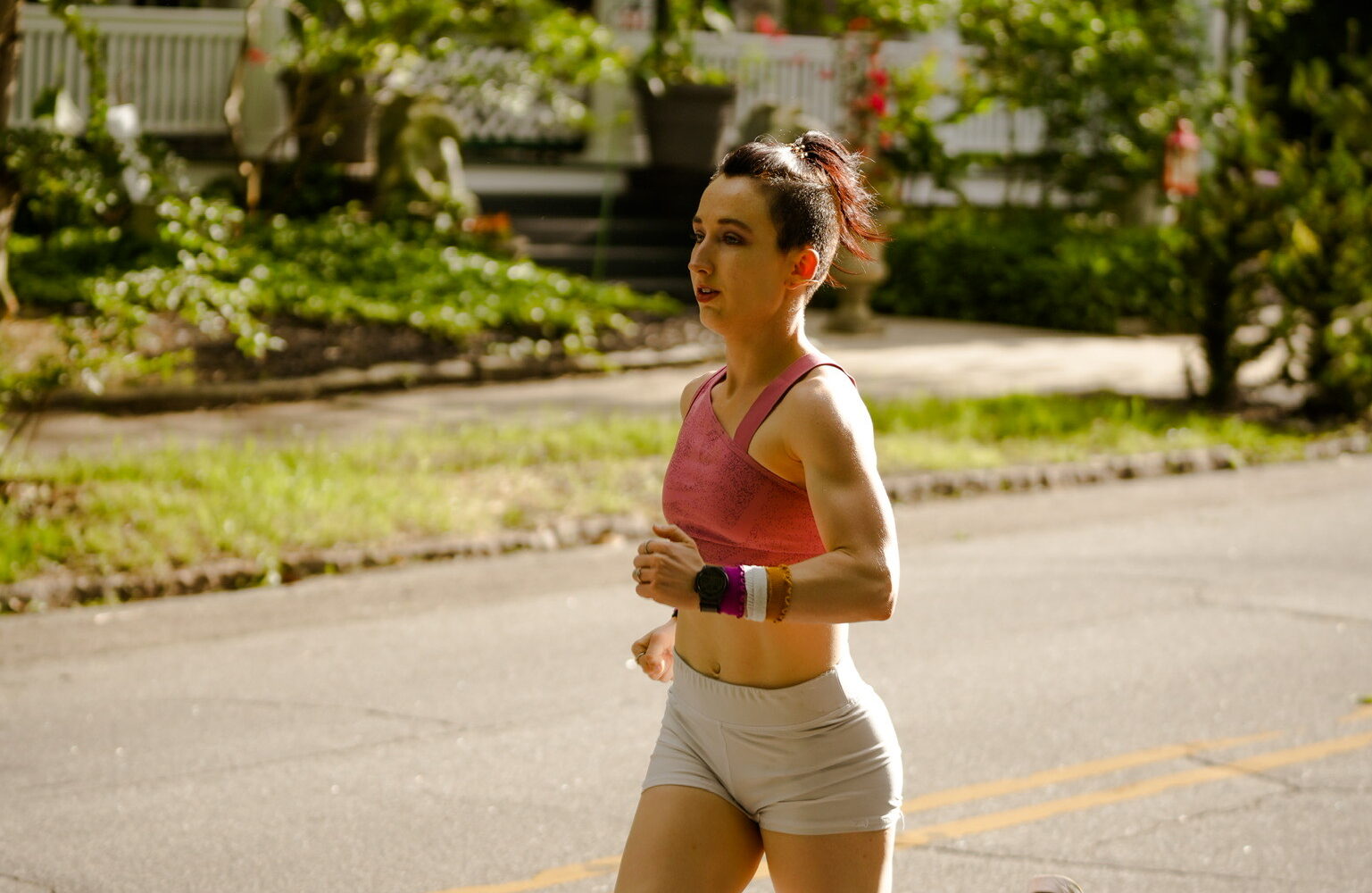
Queering the Run
My name is Molly, but most of my friends call me Marco. I am queer, gender-expansive dancer, and a member of the Raleigh running community. My gender and sexuality indisputably contextualize both my dance journey and my running journey. Runologie offered me a platform during Pride Month to share my reflections on how these identities and journeys intersect. This is my story.
My journey with running did not actually start with running. I always share the caveat that I’m NOT a runner – I’m a dancer. My first love was, and is, ballet. I started ballet at age 3, and fell in love. I was more muscular and less flexible than the other girls in my classes, and always excelled in the “boy” combinations – the ones containing more ambitious and explosive leaping. Though I never quite fit into the ballet body type, my love for the art form remained uninhibited. Through ballet, I found my voice.
Every genre of dance has a movement vocabulary, an encyclopedia of steps curated into infinite combinations, to tell stories and make statements, moving through every plane of motion. Few things render me more empowered than a petite allegro, sticking a croisé landing from a pirouette, or a grande plié à la seconde with dramatic port de bras. When I communicate with my body via this movement vocabulary, I feel louder, and find more clarity, than most spoken words could ever convey.
At the peak of my ballet career, I started running a few times a week in an attempt to build endurance for longer repertoire pieces. I ran around the block with the classical music of said repertoires blaring from my corded CD Walkman, visualizing sos de chats to the sound of symphonies. Running became, not a sport that I practiced, but rather a vehicle through which I enhanced my physical ability to live out my deep love for ballet.
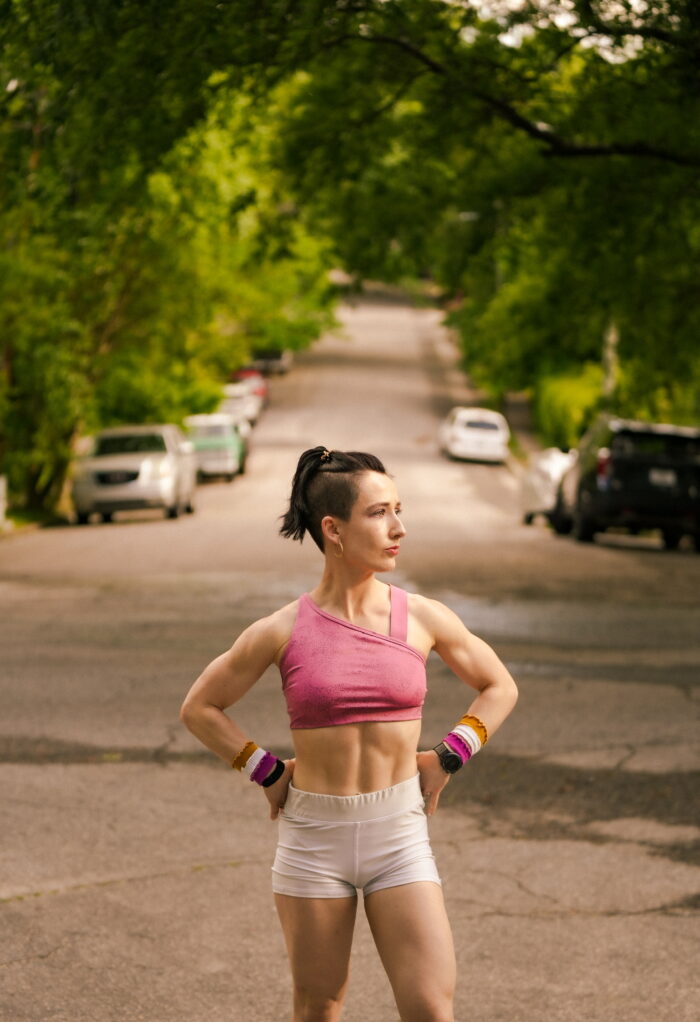
I ended up leaving the ballet world due to an eating disorder, but was left yearning for new ways to move my body that involved less pink tights, aesthetic-based success, and endless hours in front of a mirror. With this goal in mind, I thought back to the running I had done to train up my ballet endurance, and walked onto my high school spring track season during my senior year.
There were people of ALL body types, and an event for EVERY type of athlete. I didn’t have to fit in the often narrow, sinewy, dying swan or fairytale princess box into which I found myself conforming during ballet. With track, I could try it all.
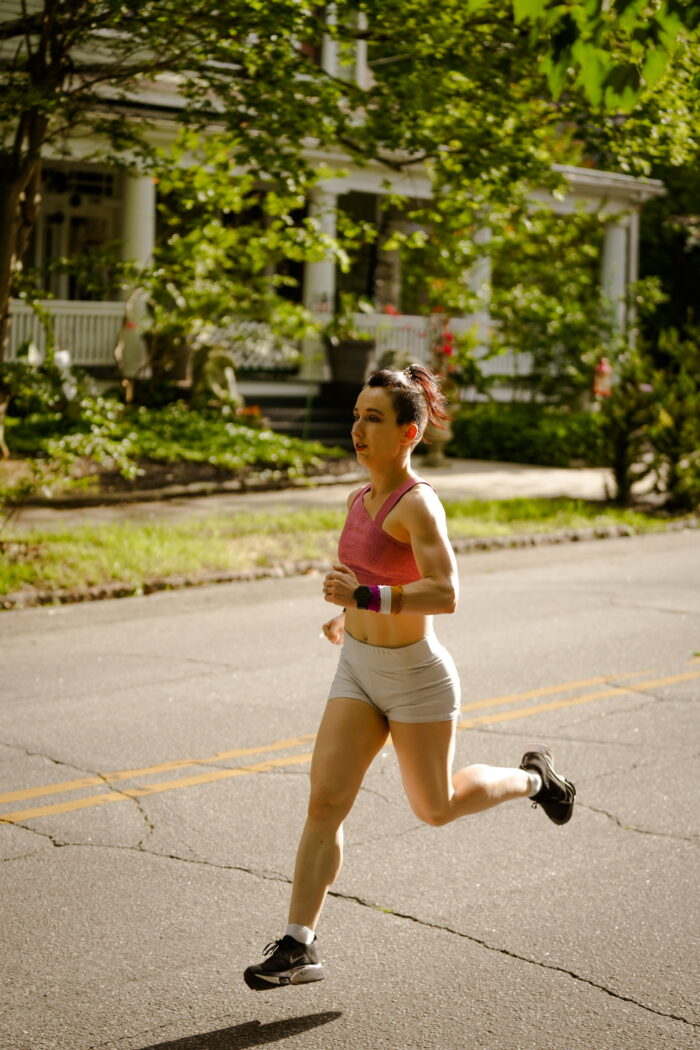
Sprinting was my favorite. I felt like I was flying. Similarly, when I dance, I feel like I’m flying. I always loved the grand allegro combinations the most. Sprinting was another way to fly – by proxy, it was another way to dance.
Next thing I knew, I had signed on to run for the NCAA/ODAC conference at Guilford College. To my chagrin, my coaches quickly realized I had too much endurance built up from years of ballet to specialize in events that were under a minute in duration. They bumped me over into distance events, and I ended up being top 5 on the team.
Running felt different in college. The NCAA environment imposed so much pressure. I raced every weekend, and couldn’t listen to music while racing. In ballet, the culmination repertoires, the race “equivalents”, were CENTERED around music. Until college, running had always been a means to SURROUND myself with music and visions of dance routines, not to run circles in silence.
I ended up leaving the team in my junior year. Running had become my whole identity, and I had been holding an aspect of my identity deep inside without offering it the query and care that it deserved. Without three a day practices and weekly races, I had much more time and headspace to tend to what I had ignored for so long: my sexuality.
I came out right after leaving the team. My coaches were incredibly supportive, both of my departure from the team and of this new piece of my identity that I chose to share. Suddenly, I had time to build more community with people outside of my team, people
who loved like me. I started dating women, and it was like taking a deep breath that expanded my heart as much as it expanded my lungs.
I was living and loving joyfully, and was ready to MOVE joyfully again.
I started dancing again with all my new free time, more freely, creatively, uninhibitedly, and queerly than ever before. I hadn’t felt this freedom with dance in the frankly heteronormative and regimented world of ballet.
When I came out, I let my heart communicate. When I dance, I let my body communicate. Dancing after coming out was a means to communicate with my heart and body simultaneously. Dancing was a way to express the authenticity I had embraced. Dancing provided the movement vocabulary for the power of courageous authenticity that no verbal vocabulary could convey.
A few years later, I went to my first drag show during Pride Month in 2018. I saw drag kings for the first time, and saw an intersection between performance art and queerness that resonated in my soul. By October, I performed drag for the first time. I selected the drag name Marco, backstage at the Legends Amateur Contest, probably 10 minutes before going onstage. It’s derived from my last name, Marcotte, and was a knee-jerk
reaction to the host asking me what name they should introduce me as in the lineup, but somehow, it fit perfectly.
Performing drag unlocked a new relationship to dance – it represented my queerness, my identity as a dancer, and the community behind both of these identities. I realized and leaned into my identity as a gender-expansive performance artist, and felt powerful and creative in previously undiscovered avenues.
Finally, I started running again, and the same magic occurred.
My running was grounded in a new purpose – a way to build endurance for my intensive dance-based drag performances, in the same way I had used it to build endurance for ballet repertoires all those years before.
Coming out was something I did for myself.
Starting to do drag was something I did for myself.
Running was, this time around, something I did for myself, not for a coach, a team, a race, or a title.
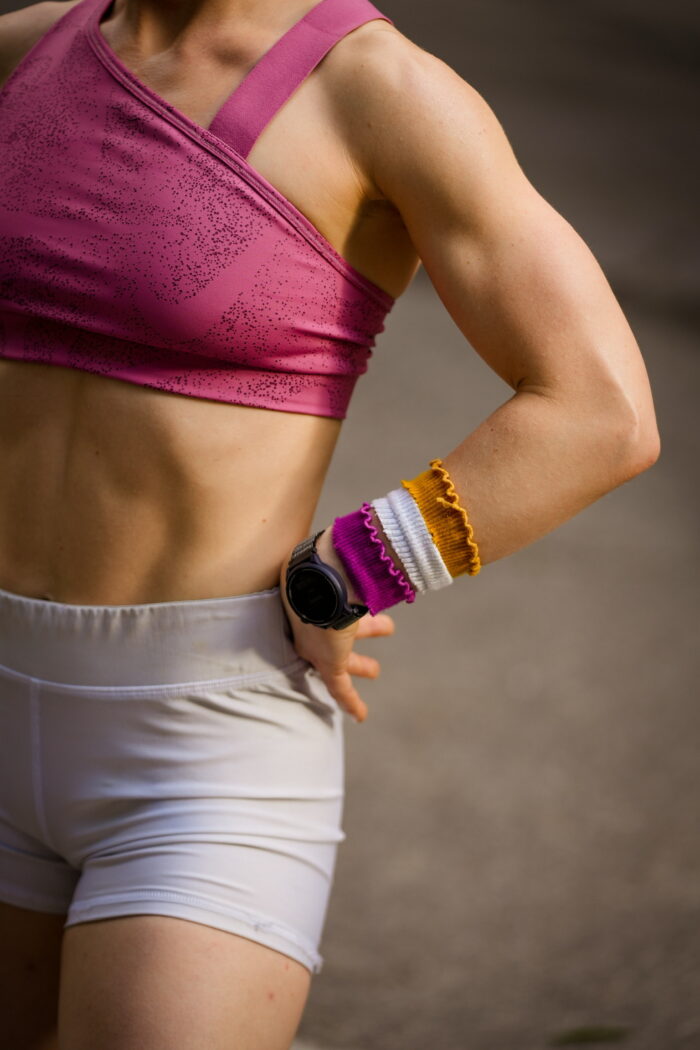
I tried to do some racing, but always fell apart mentally, and felt no fulfillment or excitement. Soon, in the same way I learned to listen to my heart when I came out, I listened to my mind when assessing my relationship to racing.
I recognized that the purpose of running for me was not to race, but to serve as a mechanism for my queerness and my dancing. Running was a time to listen to new music by queer artists and visualize drag routines. Running was a way to move through space that’s predictable and solitary, a time to envision the routines I would eventually perform in my community, but curated, one step at a time, in solitary strides through the sidewalks of downtown Raleigh.
The pandemic hit, and running became even more important. It kept me connected to drag, and to the queer community. I used my runs to plan epic post-pandemic comeback performances, and was sustained by the memories of performing in queer community spaces that, due to COVID, we could no longer occupy.
I started running at night because it reminded me of the exhilaration of preparing for a drag show. The streets were so quiet during lockdown. Things eventually opened up again, but I continued my nightly running rituals, running past the bars where I might perform later in the week week.
I memorized as many street signs as I did lyrics, and found a sense of home striding through the built environment in the same way that I found a sense of home strutting across a drag performance stage.
At the beginning of this piece, I shared something I continually iterate to folks in the running community: “I’m not a runner, I’m a dancer”. For years, I’ve feared labeling myself with an identity marker for a sport that’s so quantitative and linear in nature – you put one foot in front of the other, and your paces get faster, stagnate, or get slower. Furthermore, running never felt like a primary identity – it resonates most as a vehicle to train for my queer dance journey.
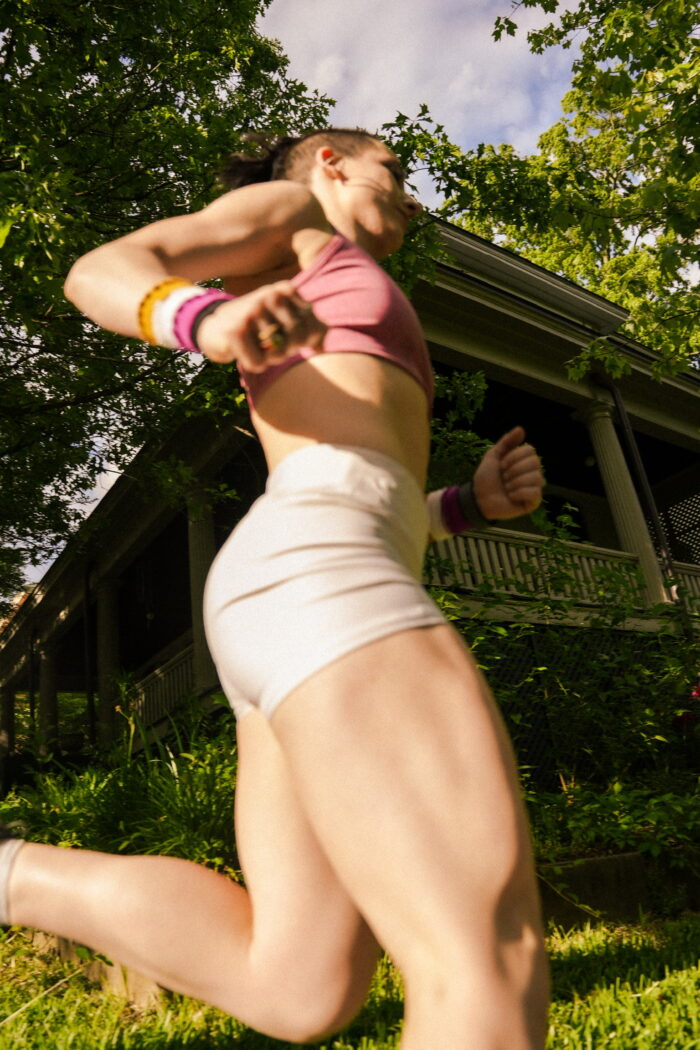
The simplicity of running draws me to it, but dance has a much more dynamic measure of success to me – the movement vocabulary is enormous. I tend to feel like a failure after a bad run. To the contrary, I can always glean a measurable indicator of success after a dance performance, whether it be nailing a complicated leap, holding a balance, or extending through my arabesque line.
Aside from running feeling secondary to dancing in my movement practices hierarchy, I have come to understand that my fear of identifying as a runner was rooted in a fear of failure. If there’s only one indicator of success, then it’s easier for me to fail. It takes courage, wherein the love for a movement practice outweighs the need for perfection in a race time.
Coming out took courage, wherein the love for myself had to outweigh the fear of ostracization, discrimination, and harm. Starting drag took courage, wherein the love for performing and dance had to outweigh the fear of failing at a new art form. I had to love myself enough to love authentically, and had to love myself enough to perform authentically. Now, I love myself enough to approach my running authentically.
There’s no way to fail at being queer, because there is no one way to be queer – we have no script.
There is no way to fail at running, because there is no one way to be a runner.
I am queer, no matter who I date, how I dress, how I occupy space, or which terms I use to identify myself.
I am a runner, no matter the pace, no matter the distance, no matter the direction, no matter if I race or not.
I discovered an abundance queer love once I stopped following the societally imposed scripts of heterosexuality.
I discovered an abundance of creative dancing once I leaned into the intersection between dancing and queerness.
I discovered an abundance in my running once I stopped self-imposing a script of what it ‘meant’ to be a runner.
When I removed self-imposed scripts for the way that I dance, or run, or love, I found the most liberation and fulfillment. I found MYSELF. Through queering my approach to running, I finally found my place in this sport.
